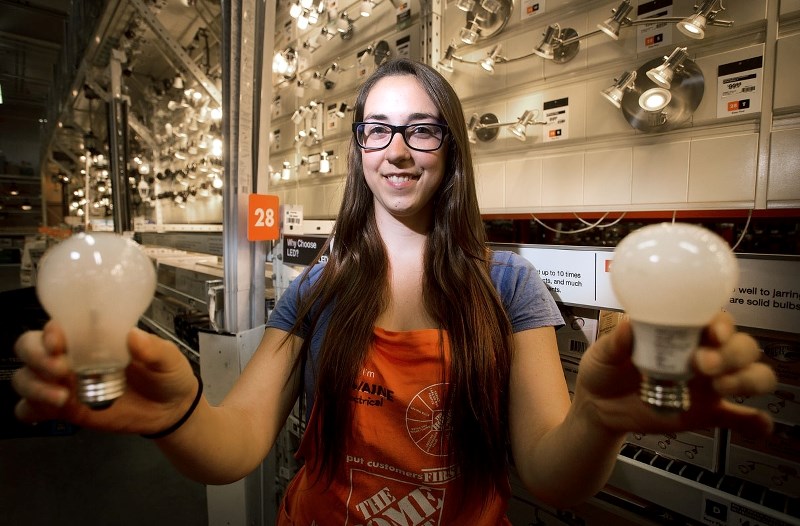When I moved into my first house, the first thing I did was curse the light bulbs.
Incandescents! The lot of them! All cranking out enough heat to turn the place into an Easy-Bake oven and wasting my money.
So the second thing I did was rip them all out and replace them with compact fluorescents (CFLs) and LEDs. It cost a lot to do them all at once, but now I basically never have to change a bulb again for a decade or so.
I did that not just because I'm a cheapskate, but also because I want to act against climate change.
Numerous studies suggest we're already seeing the effects of climate change in the forms of more extreme weather, drought, forest fires, and glacial melt. These effects are driven primarily by human-caused greenhouse gas emissions, and the more we make, the worse they get. If we want to get climate change under control, our net emissions must eventually hit zero – and the sooner, the better.
The average St. Albert resident emits about 12.3 tonnes of greenhouse gas emissions each year, the city reports. Our carbon challenge is to get that to zero.
Starting this week, The Carbon Challenge is going to look at simple, effective, and affordable steps you can take to cut carbon emissions and (usually) save money. And one of the best spots to start is lighting.
Lights burn coal
Every kilowatt-hour of electricity used in Alberta produces about 710 grams of carbon, reports Godo Stoyke, former St. Albert resident and head of the energy efficiency firm Carbon Busters, citing data from Alberta Environment. The less power we use on lights, the less worse the climate becomes.
One of the simplest ways to cut energy use for lights is to not use them. Shut off your lights when you don't use them, either by using the switch or hooking them to a motion sensor.
You can also use natural light. That can mean opening a window or installing a solar tube, which is sort of a specialized skylight. As solar tubes cost up to $600, only work on the top floor, require hacking a hole in your roof and take a long time to pay off, they're not particularly common.
The next step is to upgrade your lights, usually by swapping halogens and incandescents with CFLs and LEDs.
"CFLs and LEDs are roughly the same efficiency in some applications," Stoyke notes, with both producing about 100 lumens of light per watt. Both are about four times more efficient at making light than incandescent bulbs.
The main difference is longevity: LEDs will usually last about 25,000 hours while CFLs die after 8,000.
As 10 per cent of an average home's electricity use goes towards lighting, Stoyke estimates that replacing 10 of the most often-used incandescent bulbs in your home with LEDs or CFLS would save you about $35 a year in electricity, and pay for themselves in about 1.25 years. You'd also prevent about 319 kilograms of emissions per year.
CFL or LED?
LEDs are best used when you need focused lighting, as their light is very directional, Stoyke says. CFLs, which shoot light in all directions, are better for area lighting.
LEDs give you more "useful" light, as they don't send light up into the fixture, says Don Cherwonka, a lighting specialist with Electrical Wholesalers of Edmonton with decades of experience. They also don't burn out faster the more you turn them on and off – CFLs lose about three hours of life per switch flick, meaning you should be careful when setting the timers on motion sensors for them.
Price-wise, CFLs and LED bulbs are equivalent to 60W incandescents and cost $7 to $20 at a place like Home Depot, depending on the brand.
Cherwonka says you should check a bulb's warranty before you get it, and ask about its colour-rendering index (which reflects how well it depicts colour). Look for an index rate of 80 or better, as that's pretty close to what you get in an incandescent (97).
Pay attention to the colour temperature as well, he continues. If you have a warmer coloured house, go for a 2,700 Kelvin light. LEDs can get up to 5,000 K, which is close to daylight, but produce an intense, bluish light better suited for whites, greys and blues.
Any CFL bulbs you replace should be sent to your local recycling depot as hazardous waste, as they contain mercury. LEDs can be recycled as electronics.
There are still some fixtures out there, like the sconce lamp in my home, that won't accept CFLs or LEDs and have to be replaced altogether. That's expensive, but if they use low-lifespan bulbs like halogens, it's still often cheaper to replace the fixture in the long run, Stokye notes.
My solution? I replaced every other light in my home and left that sconce lamp off, sitting in the dark.
I glare at it on occasion.
Carbon Tracker
Step: Replace 10 incandescent bulbs with LEDs or CFLs.
Difficulty: Easy
Cost: Less than $50, depending on the brand.
Payback Period: 1.25 years.
Carbon Saved: 319 kilograms.
The Carbon Challenge
Climate change is happening, and it's being driven in most part due to our carbon emissions. Our carbon challenge is to reduce those emissions so that the climate of tomorrow is better than the one we have today. <br />The Carbon Challenge will profile different ways you can shrink your carbon footprint and (usually) save money every second week. <br />Got a carbon question? Drop me a line at [email protected].



